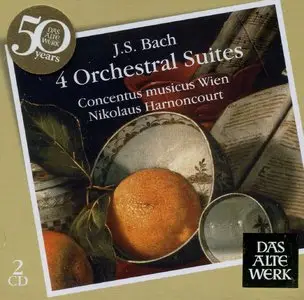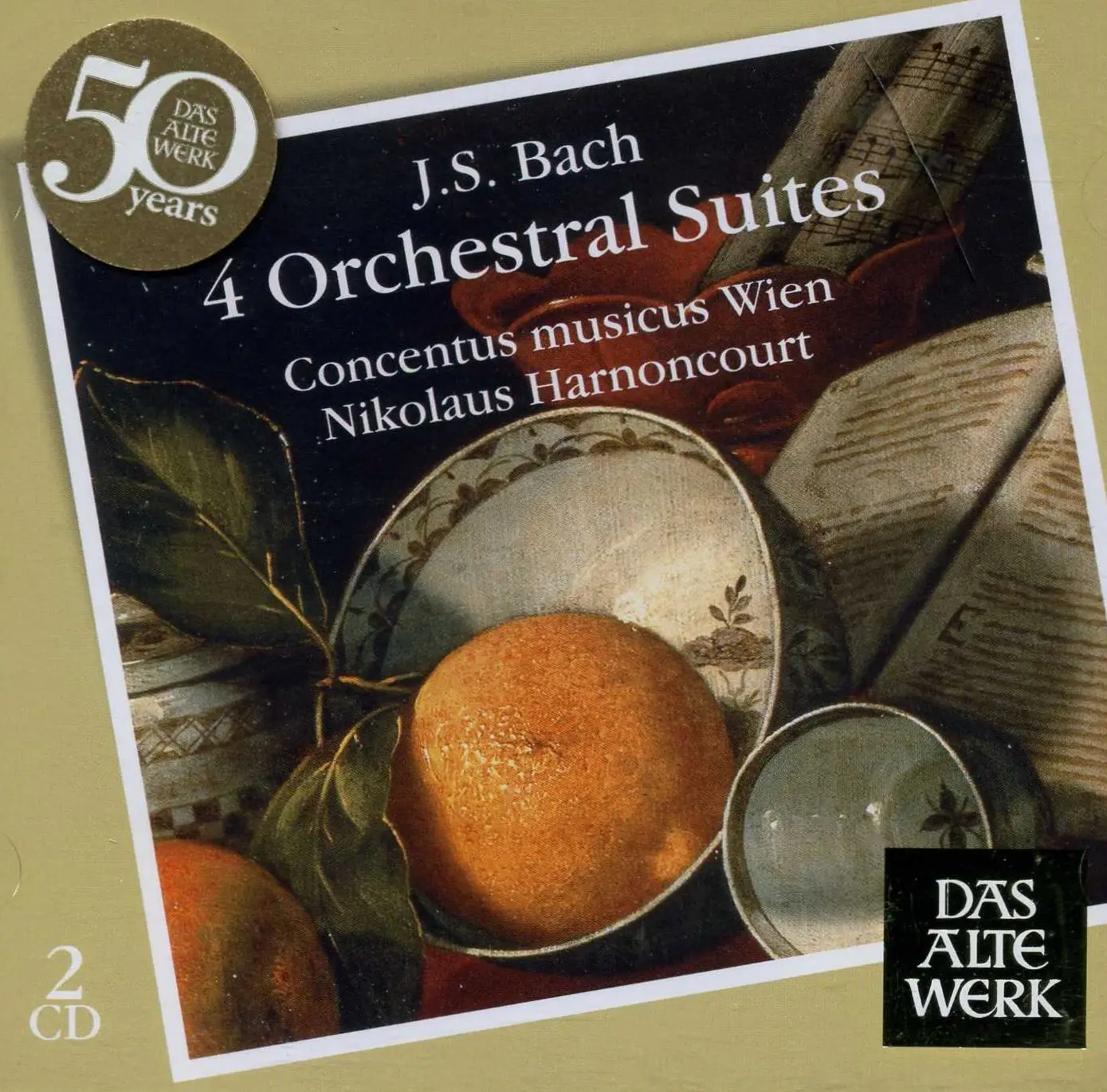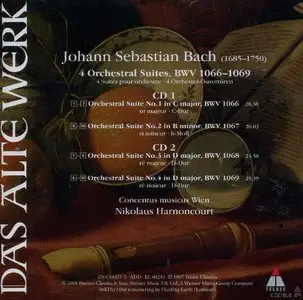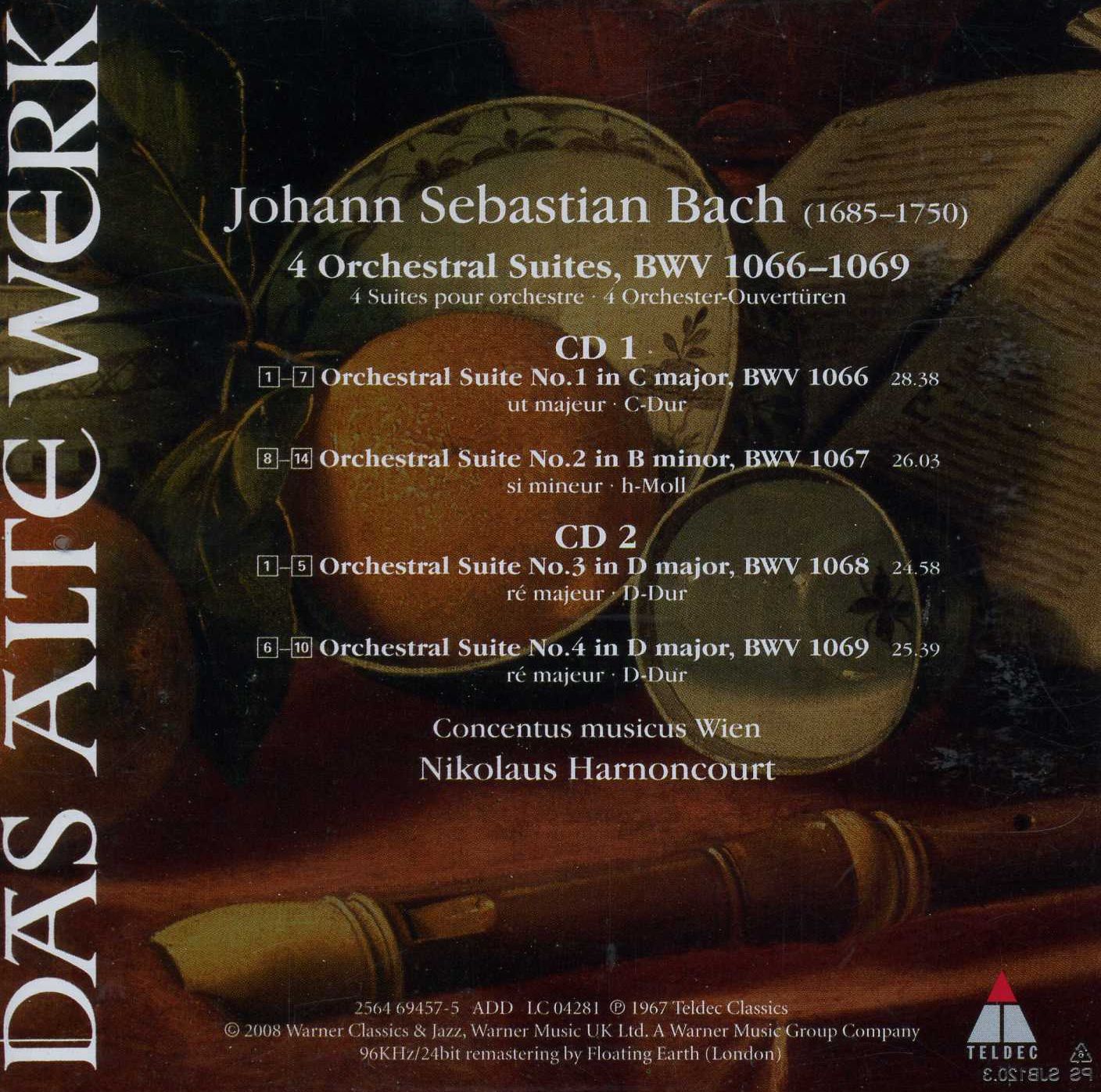Johann Sebastian BACH
4 Orchestral Suites
Concentus musicus Wien Nikolaus Harnoncourt
Baroque | 2CD | FLAC tracks, no CUE, no LOG | Scans | 550 MB | RS | TT: 1:45:09
These records represent the most determined attempt that has come my way to reproduce the performances Bach himself gave at COthen around 1720. They follow two similar records of the Brandenburg Concertos that EG reviewed without much enthusiasm last March. It is of course quite true that a performance that is musicologically 'correct' is not necessarily the most enjoyable, and many listeners will find the Menuhin recording quite musicological enough and more rewarding as regards the quality of the performance. Nevertheless as I listened to the Vienna Concentus Musicus playing the four Orchestral Suites I found my interest completely held. A vast amount of intelligence and skill has gone into the making of these discs, and they give you a great deal to think about.
The discs come with a twelve-page booklet entirely in English (this was not the case with the Brandenburg set). There are photographs of all the instruments used, both in isolated close-up and being played. The flute, one of the oboes, the bassoon, the drums and most of the stringed instruments were all made in Bach's day. The remaining oboes and the clarini trumpets are modern reconstructions of old instruments, the trumpets being curled in circles like a horn. Gut strings are used, and the violins, viola and 'cello have been restored to their eighteenth-century form as regards bridge, soundpost, bass bar and neck. In the B minor Suite there is only one instrument to each part; in the others there are three first violins, two seconds, and one viola, 'cello and double bass. These are probably the numbers available to Bach at COthen.
You would not expect the balance to be satisfying with so few string players, but it is. Yet I did not detect anything obtrusively artificial, apart from a sensible emphasis on the harpsichord. The balance works not so much because of the placing of the microphones as because it worked in Bach's day; which, come to think of it, is not altogether surprising. The trumpets, though exciting in quality do sound much less aggressive than modern ones, and this is a huge help. Also the drums are cleaner in sound and yet less smothering. Even in the tuttis you can hear quite clearly what the strings are playing. The fact that the string tone is not what we are used to seems due as much to the fewness of the players as to the reconstruction of the instruments and their gut strings. Inevitably it is a scratchier sound, less mellow than what we usually hear, yet it has a sweetness of its own, and it grows on you. To my ears the flute sounds just like a modern one, but the oboes are strikingly different, more particularly when playing on their own, and a very pleasant quality it is. All the woodwind players have to battle against difficulties they would not have faced with modern instruments. In the eighteenth century flutes, oboes and bassoons had very few keys, and this lack causes all sorts of technical problems especially in quick passages. On these records one is sometimes aware that the player is being taxed to the utmost, as no doubt his predecessor was at COthen. Ensemble is not always quite as good as the most pernickety of us expect, but this is not a fair way of expressing the point. Considering the extra difficulties the playing is astonishingly good. In the middle section of the Polonaise in the B minor Suite the flautist seems to be having difficulty in snatching his breaths, and the other players have to wait for him at the ends of his phrases. I am not sure why an old flute should be more difficult in this respect than a modern one; perhaps it isn't.
The booklet includes a long and interesting history of the suite by Nikolaus Harnoncourt, who directs the ensemble and plays the 'cello in it. He regards the opening section of each suite as being in allemande style, and this leads him to take these opening sections fairly fast; though not so fast as Thurston Dart on the old Oiseau-Lyre discs. The fact that the opening of Suite No. 4 is ineffective is probably Bach's fault, in the main. Mr Harnoncourt thinks that all dances had a tendency to get slower as time went on, and he quotes a writer of 1703 as saying that the court minuet was orginally "fast and merry". This would seem to imply that it was nothing of the sort by 1703, but I cannot believe the minuet was ever played as slowly as it is on these records. And does it follow that it was slower still in Mozart's time? The second minuet in Suite No. 1 falls apart at this tempo, and the players are pushed into exaggerating the phrasing in their attempts to make something of it. (Also the trills in
There is very little variety as regards loudness. The famous Air in Suite No. 3 plods along at a steady mezzo-forte, and sounds expressionless. Perhaps that is how Bach wanted it, but I hope not. The Sarabande in Suite No. 2 is played with notes inegales. If the convention is needed here, it must be needed in other pieces as well; though I for one do not much want it anywhere in these suites, certainly not as done here. I doubt if the players themselves were happy about it. Also there should be an appoggiatura in the bass line at bar 2, even though Bach did not write one, to balance the appoggiatura in the top line at bar 1; the two lines, it will be remembered, are in canon, and whatever the first player did the second would have done too. Occasionally an unexpected note is accented for reasons I could not follow. For instance the second note (it is a fourth beat) in the Gavotte in Suite No. 1.
For polish and artistry I would not rank these discs quite as high as the Menuhin set. If you want old-fashioned (T mean pre-war) con amore playing, you will prefer the Ca,sals performance to either, though personally I feel that Casals carries indifference to Baroque style altogether too far. It's like Hamlet in modern dress, and I'm not too keen on that either. Richter and the Munich Bach Orchestra do attempt the Baroque style with reasonable success, and probably with about the same numbers of instruments as on the new discs. I can't put the Vienna Concentus Musicus at the top. And yet it might well be the version I should want to hear most. R.F.
Source: Gramophone Archive
The discs come with a twelve-page booklet entirely in English (this was not the case with the Brandenburg set). There are photographs of all the instruments used, both in isolated close-up and being played. The flute, one of the oboes, the bassoon, the drums and most of the stringed instruments were all made in Bach's day. The remaining oboes and the clarini trumpets are modern reconstructions of old instruments, the trumpets being curled in circles like a horn. Gut strings are used, and the violins, viola and 'cello have been restored to their eighteenth-century form as regards bridge, soundpost, bass bar and neck. In the B minor Suite there is only one instrument to each part; in the others there are three first violins, two seconds, and one viola, 'cello and double bass. These are probably the numbers available to Bach at COthen.
You would not expect the balance to be satisfying with so few string players, but it is. Yet I did not detect anything obtrusively artificial, apart from a sensible emphasis on the harpsichord. The balance works not so much because of the placing of the microphones as because it worked in Bach's day; which, come to think of it, is not altogether surprising. The trumpets, though exciting in quality do sound much less aggressive than modern ones, and this is a huge help. Also the drums are cleaner in sound and yet less smothering. Even in the tuttis you can hear quite clearly what the strings are playing. The fact that the string tone is not what we are used to seems due as much to the fewness of the players as to the reconstruction of the instruments and their gut strings. Inevitably it is a scratchier sound, less mellow than what we usually hear, yet it has a sweetness of its own, and it grows on you. To my ears the flute sounds just like a modern one, but the oboes are strikingly different, more particularly when playing on their own, and a very pleasant quality it is. All the woodwind players have to battle against difficulties they would not have faced with modern instruments. In the eighteenth century flutes, oboes and bassoons had very few keys, and this lack causes all sorts of technical problems especially in quick passages. On these records one is sometimes aware that the player is being taxed to the utmost, as no doubt his predecessor was at COthen. Ensemble is not always quite as good as the most pernickety of us expect, but this is not a fair way of expressing the point. Considering the extra difficulties the playing is astonishingly good. In the middle section of the Polonaise in the B minor Suite the flautist seems to be having difficulty in snatching his breaths, and the other players have to wait for him at the ends of his phrases. I am not sure why an old flute should be more difficult in this respect than a modern one; perhaps it isn't.
The booklet includes a long and interesting history of the suite by Nikolaus Harnoncourt, who directs the ensemble and plays the 'cello in it. He regards the opening section of each suite as being in allemande style, and this leads him to take these opening sections fairly fast; though not so fast as Thurston Dart on the old Oiseau-Lyre discs. The fact that the opening of Suite No. 4 is ineffective is probably Bach's fault, in the main. Mr Harnoncourt thinks that all dances had a tendency to get slower as time went on, and he quotes a writer of 1703 as saying that the court minuet was orginally "fast and merry". This would seem to imply that it was nothing of the sort by 1703, but I cannot believe the minuet was ever played as slowly as it is on these records. And does it follow that it was slower still in Mozart's time? The second minuet in Suite No. 1 falls apart at this tempo, and the players are pushed into exaggerating the phrasing in their attempts to make something of it. (Also the trills in
There is very little variety as regards loudness. The famous Air in Suite No. 3 plods along at a steady mezzo-forte, and sounds expressionless. Perhaps that is how Bach wanted it, but I hope not. The Sarabande in Suite No. 2 is played with notes inegales. If the convention is needed here, it must be needed in other pieces as well; though I for one do not much want it anywhere in these suites, certainly not as done here. I doubt if the players themselves were happy about it. Also there should be an appoggiatura in the bass line at bar 2, even though Bach did not write one, to balance the appoggiatura in the top line at bar 1; the two lines, it will be remembered, are in canon, and whatever the first player did the second would have done too. Occasionally an unexpected note is accented for reasons I could not follow. For instance the second note (it is a fourth beat) in the Gavotte in Suite No. 1.
For polish and artistry I would not rank these discs quite as high as the Menuhin set. If you want old-fashioned (T mean pre-war) con amore playing, you will prefer the Ca,sals performance to either, though personally I feel that Casals carries indifference to Baroque style altogether too far. It's like Hamlet in modern dress, and I'm not too keen on that either. Richter and the Munich Bach Orchestra do attempt the Baroque style with reasonable success, and probably with about the same numbers of instruments as on the new discs. I can't put the Vienna Concentus Musicus at the top. And yet it might well be the version I should want to hear most. R.F.
Source: Gramophone Archive
CD1: Orchestral Suite No. 1 in C major, BWV 1066
[1] Ouverture
[2] Courante
[3] Gavotte I/II
[4] Forlane
[5] Minuet I/II
[6] Bourrée I/II
[7] Passepied I/II
Orchestral Suite No. 2 in B minor, BWV 1067
[8] Ouverture
[9] Rondeau
[10] Sarabande
[11] Bourrée I/II
[12] Polonaise (Lentement) - Double
[13] Minuet
[14] Badinerie
CD2: Orchestral Suite No. 3 in D major, BWV 1068
[1] Ouverture
[2] Air
[3] Gavotte I/II
[4] Bourrée
[5] Gigue
Orchestral Suite No. 4 in D major, BWV 1069
[6] Ouverture
[7] Bourrée I/II
[8] Gavotte
[9] Menuet I/II
[10] Réjouissance
Password: www.AvaxHome.ru
Part1
Part2
Part3
Part4
Part5
[1] Ouverture
[2] Courante
[3] Gavotte I/II
[4] Forlane
[5] Minuet I/II
[6] Bourrée I/II
[7] Passepied I/II
Orchestral Suite No. 2 in B minor, BWV 1067
[8] Ouverture
[9] Rondeau
[10] Sarabande
[11] Bourrée I/II
[12] Polonaise (Lentement) - Double
[13] Minuet
[14] Badinerie
CD2: Orchestral Suite No. 3 in D major, BWV 1068
[1] Ouverture
[2] Air
[3] Gavotte I/II
[4] Bourrée
[5] Gigue
Orchestral Suite No. 4 in D major, BWV 1069
[6] Ouverture
[7] Bourrée I/II
[8] Gavotte
[9] Menuet I/II
[10] Réjouissance
Password: www.AvaxHome.ru
Part1
Part2
Part3
Part4
Part5





